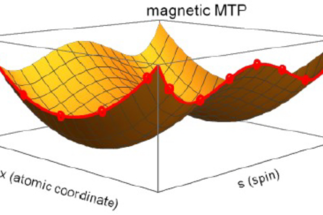Designing Materials for Structural Applications
Together with our experimental colleagues, we investigate the underlying atomic-scale mechanisms leading to macroscopic properties like formability and toughness. For instance, we can directly probe impact of solute segregation on grain boundary embrittlement, study how dislocations interact with other defects, or investigate precipitate nucleation. Both motivated by and helping to explain experimental observations, we move from the "guess and check" metallurgy of past centuries towards intentional and guided designs for materials withs structural applications.
The Magnetic Moment Tensor Potentials (mMTPs) are a class of machine-learning interatomic potentials, which could accurately reproduce both vibrational and magnetic degrees of freedom as provided, e.g., from first-principles calculations [1]. Application to prototypical bcc iron has demonstrated that these potentials are capable to quantitatively approximate local magnetic moments, energies, and forces for various magnetic states. In this project, a number of applications such as the computation of phonon spectra in ferro- and paramagnetic states as well as molecular-dynamics simulations including spin-flips are explored.
[more]
Interstitial alloying can improve the mechanical properties of high-entropy alloys (HEAs). In some cases, the interstitial-alloying impact is very different from those in conventional alloys. We investigate the effect of interstitial alloying in fcc CrMnFeCoNi HEA as well as bcc refractory HEAs, particularly focusing on the solution energies and impact on, e.g., stacking fault energies, based on first-principles calculations. Our results clarity, e.g., that the interstitial solution energy in HEAs is no longer a single value but shows a substantial distribution due to the dependence on local chemical environments.
more
This project aims at understanding the mechanical properties of glasses on the basis of their structure and the relevant atomic-scale deformation mechanisms.
more
A high degree of configurational entropy is a key underlying assumption of many high entropy alloys (HEAs). However, for the vast majority of HEAs very little is known about the degree of short-range chemical order as well as potential decomposition. Recent studies for some prototypical face-centered cubic (fcc) HEAs such as CrCoNi showed that short-range order (SRO) can influence critical materials properties as, e.g., stacking fault energies. For refractory HEAs, due to slow diffusivity chemical ordering may hardly ever be achieved under typical experimental conditions but could potentially influence creep properties long-term applications. In this project we therefore study the phase stability and short-range order of selected fcc as well as bcc refractory HEAs computationally.
more



